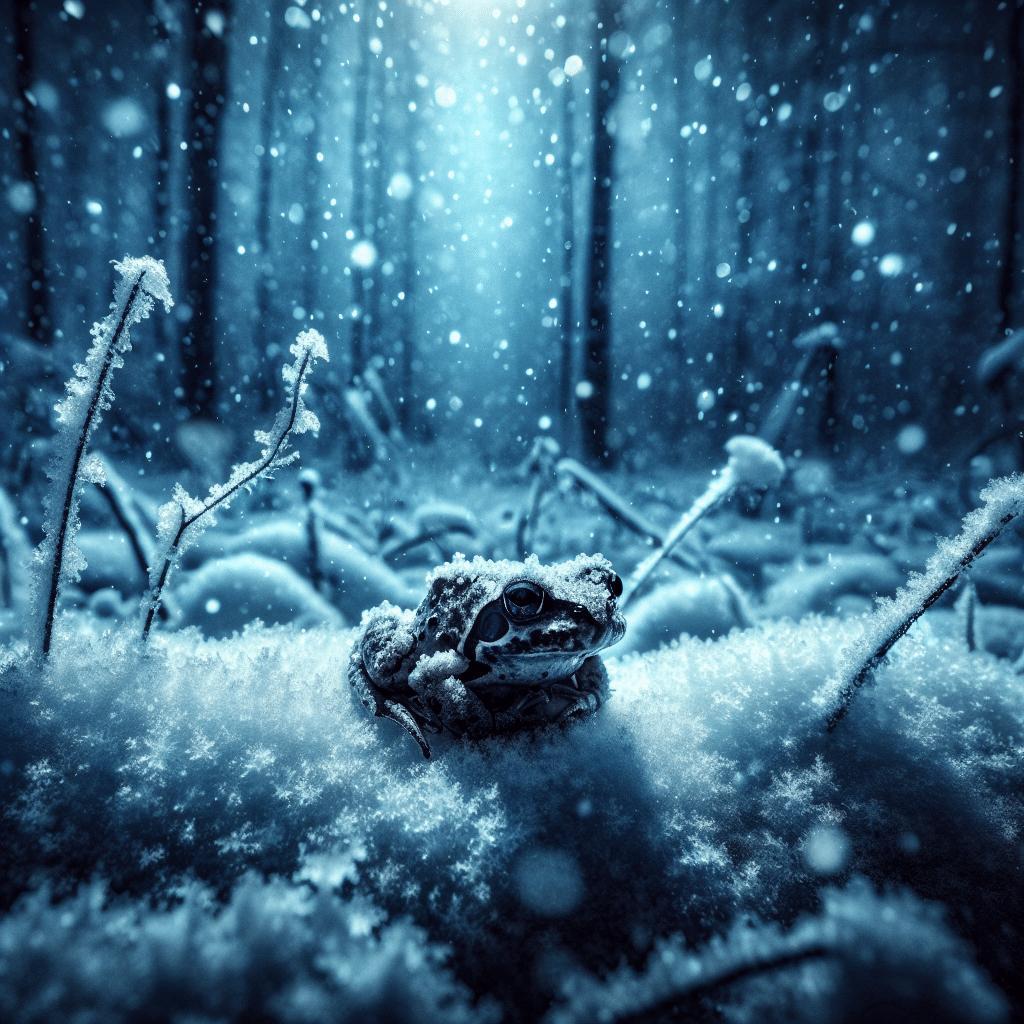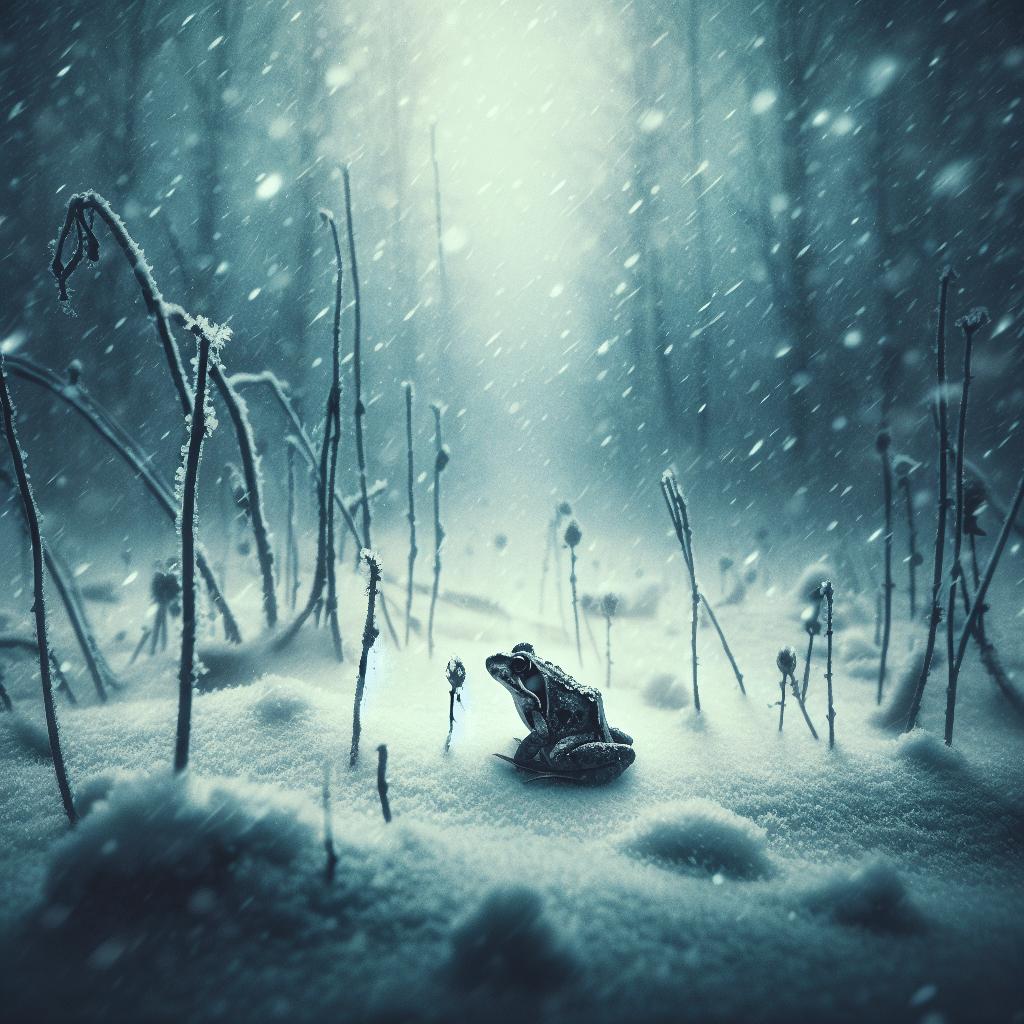Imagine you’re strolling by a frozen pond on a chilly winter day, and a thought strikes you: How do those cold-blooded critters, like frogs, manage to survive the harsh winter? It seems almost impossible, doesn’t it? But nature has a knack for the incredible, and frogs are no exception. Brace yourself for a fascinating journey into the world of frogs and their astonishing winter survival strategies. From biological antifreeze running through their veins to their slow-motion, suspended animation, you’re about to discover how these resilient amphibians make it through the coldest time of the year.

Understanding Frog Biology and Behavior
You may be curious about the tiny amphibians hopping around your backyard or local pond. Frogs are fascinating creatures, and to truly appreciate them, it’s essential to delve into their biology and behavior. These aspects are crucial to understanding how they survive and thrive in their environments, especially during the challenging winter months.
Adaptive physiology of frogs
First things first, frogs have an incredible capacity to adapt to various environments. Their physiology allows them to exploit a range of habitats, from swamps to treetops. Have you ever touched a frog? If you have, you might have noticed their moist skin. This isn’t just for show – it’s essential for respiration. Frogs breathe not only through their lungs but also through their skin, which must stay wet for this to work effectively. This unique feature also helps them regulate their body temperature.
Frogs’ lifecycle and seasonal behavior
The lifecycle of a frog is one of those fascinating nature documentaries playing out right in your backyard. From egg to tadpole, to adult frog, each stage has its own set of behaviors and challenges. Seasonality plays a key role in their behavior; they’re active and vocal during the warmer months, which is their breeding season. As the days shorten and the temperatures drop, frogs alter their behavior significantly as they prepare for the colder months.
The role of hibernation in frog survival
If you’ve ever wondered where frogs go during winter, hibernation is the magic word. Just like bears, frogs enter a state of dormancy. This is crucial for their survival, as it allows them to conserve energy when food is scarce and temperatures are too low for their bodies to function as they do in summer.
The Hibernation Process in Frogs
The image of a frog tucked away asleep for the winter is both accurate and incomplete. Let’s unwrap the mysteries of hibernation and why it’s an essential part of a frog’s life cycle.
What is hibernation and why do frogs hibernate?
Hibernation is effectively a deep sleep that helps frogs conserve energy. As cold-blooded creatures, frogs rely on external temperatures for their metabolism. When it’s cold, their metabolism slows down, so hibernation becomes a way to make it through the season with minimal energy use.
Different strategies of frog hibernation
Your local frogs might employ different hibernation strategies depending on their species and habitat. Some tuck themselves into the mud at the bottom of ponds, taking advantage of the water’s relatively stable temperature. Others might burrow into the ground or leaf litter. Each strategy has its benefits and risks.
Physiological changes in frogs during hibernation
As frogs enter hibernation, their bodies undergo several physiological changes. Their heart rates slow, and their body temperatures drop to nearly match their surroundings. In some species, their bodies even produce a kind of antifreeze substance that prevents vital organs from freezing – how cool is that?

Types of Habitats and Their Winter Impact
Wondering where frogs spend the winter? Their habitats play a crucial role in how well they can ride out the cold months.
Aquatic habitats and winter resilience
Frogs that hibernate underwater, usually at the bottom of a pond or a stream, benefit from the insulating properties of water. It might be chilly, but it’s stable and prevents them from freezing solid.
Terrestrial habitats and isolation from the cold
Other frogs avoid the water for winter burrows in the ground, leaf litter, or logs. These terrestrial spots can offer protection from freezing temperatures and create a stable micro-environment for a frog’s winter slumber.
Effects of habitat quality on frog winter survival
The quality of the habitat is also pivotal. A clean, unpolluted environment gives frogs a better shot at making it through the winter. Pollution can disrupt their delicate physiological processes, impacting their hibernation and ultimate survival.
Species-Specific Winter Survival Strategies
Not all frogs are created equal when it comes to winter survival. It’s a rough season, and different species handle it in their unique ways.
Variation in winter survival among frog species
Some frog species are better equipped for the cold than others. Their geographic location, habitat preference, and physiology play into their specific winter survival strategies.
Case studies of specific frog species and their overwintering tactics
Let’s consider the wood frog, notorious for its ability to survive being frozen. In its northern range, the wood frog tolerates the formation of ice crystals in its body, a process that would be fatal for many other organisms.
Adaptations to extreme cold in certain frog species
Looking at the extreme cold adaptations, some frogs have developed methods to control the freezing process in their bodies, ensuring that ice forms only where it won’t cause damage. This incredible adaptation is the difference between life and death in frigid conditions.

Climate and Environmental Factors Affecting Frogs in Winter
Frogs have been dealing with winter long before humans started pondering climate change. But the environment is changing, and that’s affecting even the sleepiest hibernating frog.
Impact of climate change on winter temperatures and frog survival
As temperatures fluctuate due to climate change, it can interrupt the normal hibernation periods for frogs. Warmer winters might cause frogs to emerge too early, facing a food shortage and the risk of a sudden temperature drop.
Role of snow cover in insulating hibernating frogs
A thick blanket of snow can actually help insulating frogs from extreme cold. It acts much like a down comforter for a hibernating frog beneath the ground, helping to maintain a stable temperature even when the air above is bitterly cold.
Influence of winter precipitation patterns on frog habitats
Changes in precipitation, both rain, and snow affect the quality and stability of frog habitats. Flooding can disrupt hibernating frogs, and a lack of snowfall can leave them vulnerable to temperature swings.
Threats to Frogs During Winter Months
Even as they snooze away the winter, frogs are not free from danger. Several threats loom over them during these vulnerable months.
Predation risks for hibernating frogs
While hibernation helps frogs escape the worst of the cold, it can leave them at risk of predation. Frogs are slower and less responsive during this time, making them easier targets for predators.
The problem of habitat disturbance and destruction
Human activities such as development and pollution pose significant threats to frog habitats — particularly delicate during winter months.
Disease and its exacerbated risk in cold months
Certain diseases also take a toll on frog populations. Frogs with lowered immunity during hibernation are more susceptible to infections, which can spread rapidly through populations.
Conservation Efforts to Protect Frogs in Winter
Ok, so frogs are facing a frosty uphill battle, but conservationists are working hard to ensure they have a fighting chance.
Habitat protection and restoration initiatives
Protecting and restoring wetlands and other critical frog habitats are vital. Such efforts ensure that frogs have access to safe hibernation sites and healthy environments year-round.
Captive breeding and reintroduction programs
In some cases, captive breeding and reintroduction programs give frog populations a boost. Scientists can breed frogs in safe environments and reintroduce them into the wild, bolstering numbers and genetic diversity.
Public awareness and education on the plight of frogs in winter
Raising awareness about frogs and the challenges they face is essential. The more you know, the more you can do to help — even if it’s just being careful about pollution or supporting wetland conservation efforts.
Research on Frog Winter Survival
To protect our ribbiting friends, scientists are digging deep into what makes them tick, especially in the colder months.
Studies on the physiological mechanisms of hibernation
Understanding the nuts and bolts of frog hibernation is key to helping them survive. Research into these physiological processes can lead to better conservation strategies.
Tracking and monitoring frog populations
Keeping tabs on frog populations can reveal how they’re faring over the winter and help identify at-risk groups in need of help.
Developing predictive models for frog survival rates
With enough data, scientists can create models to predict how frog populations might respond to various environmental conditions, giving conservationists the upper hand in protecting them.
The Role of Citizen Science in Understanding Frog Winter Ecology
Did you know you can help frogs, even if you’re not a scientist? Citizen science empowers regular folks like you to contribute to the larger understanding of frog ecology.
Community-based monitoring programs
Many regions have monitoring programs that allow you to help keep an eye on the local frog population. Your observations can be invaluable to scientists tracking frog health and numbers.
Contribution of citizen data to scientific research
When you participate in citizen science projects, your data feeds into broader research initiatives. Your backyard frog count can actually help shape global understanding!
Encouraging public engagement and stewardship
Getting involved in frog monitoring not only helps the frogs but can also be incredibly rewarding. It fosters a sense of stewardship for the environment and can ignite a passion for conservation in both young and old.
Frequently Asked Questions About Frogs in Winter
Finally, let’s hop into some frequently asked questions about frogs during their winter siesta.
How do frogs breathe while hibernating under ice?
Remember that skin breathing we talked about? That’s how they do it. Even under the ice, frogs can absorb oxygen from the water passing over their skin.
What do frogs eat during the winter?
The simple answer is nothing. Frogs enter a state of dormancy during which they do not eat. They live off their body’s energy stores until spring arrives.
Can frogs freeze and still survive?
Yes, some species like the wood frog can. They have special adaptations that allow them to survive freezing temperatures by letting their bodily fluids partially freeze.
So, will frogs survive winter? With their amazing adaptations and a little help from conservation efforts, there’s hope for these resilient amphibians. Season after season, they continue to surprise us with their remarkable strategies for braving the cold.



